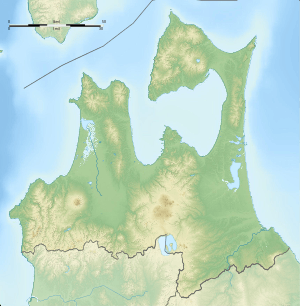Namioka Castle
| Namioka Castle 浪岡城 | |
|---|---|
| Aomori, Aomori Prefecture, Japan | |
 Namioka Castle 浪岡城  Namioka Castle 浪岡城 | |
| Coordinates | 40°43′04″N 140°36′17″E / 40.71778°N 140.60472°E |
| Type | hirayama-style Japanese castle |
| Site information | |
| Open to the public | yes |
| Condition | ruins |
| Site history | |
| Built | 1373 |
| Built by | Kitabatake clan |
| In use | Nanboku-cho period |
| Demolished | 1578 |
Namioka Castle (浪岡城 Namioka jō) was a Muromachi period Japanese castle located in what is now the city of Aomori, Aomori Prefecture, in the Tōhoku region of far northern Japan. It is protected by the central government as a National Historic Site.
Situation
Namioka Castle is located on a river terrace of the Namioka River, in former Namioka town, south of the center of Aomori city. The location commands a central location to cover the entry to the Tsugaru Plain from the east.
The castle consisted of eight motte-and-bailey enclosures, approximately 1200 meters long by 600 meters wide. As was typical for the time, the fortifications consisted primarily of wooden palisades and earthen ramparts, each guarded by moats. The moats were 20 meters wide by 5 meter deep. There was no donjon in the central bailey.
History
Namioka Castle was constructed around 1373, during the early Nanboku-chō period, by the Namioka-Kitabatake clan. During the struggles between Emperor Go-Daigo and Ashikaga Takauji, Kitabatake Akiie, who had been sent to rule northern Japan from Taga Castle was appointed Chinjufu-shōgun. In December 1335, Kitabatake Akiie and his father Kitabatake Chikafusa drove Ashikaga Takauji from Kyoto to Kyushu. However, Takauji was able to raise a new army the following year, and after defeating Emperor Go-Daigo at the Battle of Minatogawa, was able to drive him into exile in Yoshino. Kitabatake Akiie was subsequently defeated by the forces of Kō no Moronao at the Battle of Ishizu in 1338. His younger brother, Kitabatake Akinobu was also unable to hold Taga Castle and other strongholds against the victorious Ashikaga forces and fled to the far north of Honshū, seeking the protection of the Nanbu clan based at Sannohe Castle and the Andō clan which controlled Tosaminato Port on the Sea of Japan and changed his family name to “Namioka”.
In 1562, during the Sengoku period, there was an internal conflict within the Namioka clan, in which Namioka Tomokazu (1532-1562) was killed. Although the revolt was suppressed, the weakened Namioka clan was unable to resist an attack in 1578 by Oura Tamenobu, who had seized the Tsugaru region and who had declared independence from the Nanbu. The castle was soon abandoned thereafter.
Current situation
In 1940 the site of Namioka Castle was proclaimed a National Historic Site. The site of the castle remains in ruins, however, there is a museum at the site.
See also
External links
- Aomori City official site (in Japanese)
- Aomori prefectural Government site (in Japanese)